The Evolution of the Two Largest Tropical Ice Masses since the 1980s
Abstract
:1. Introduction
Study Sites
2. Materials and Methods
2.1. Data Sets
2.2. Semi-Automated Method to Determine Glacial Extents
3. Results
3.1. Evolution of the Quelccaya Ice Cap
3.2. Evolution of the Glaciers on Nevado Coropuna
4. Discussion
4.1. The Role of Scence Selection on Estimates of Glacial Extent
4.1.1. Optimal Time of Year for Scene Selection
4.1.2. Impact of Selecting the Wrong Scene
4.2. Updated Insights on the World’s Largest Tropical Ice Masses
4.2.1. Extent and Evolution of the Quelccaya Ice Cap
4.2.2. Extent and Evolution of the Glaciers on Nevado Coropuna
5. Conclusions
Supplementary Materials
Author Contributions
Funding
Data Availability Statement
Acknowledgments
Conflicts of Interest
Appendix A
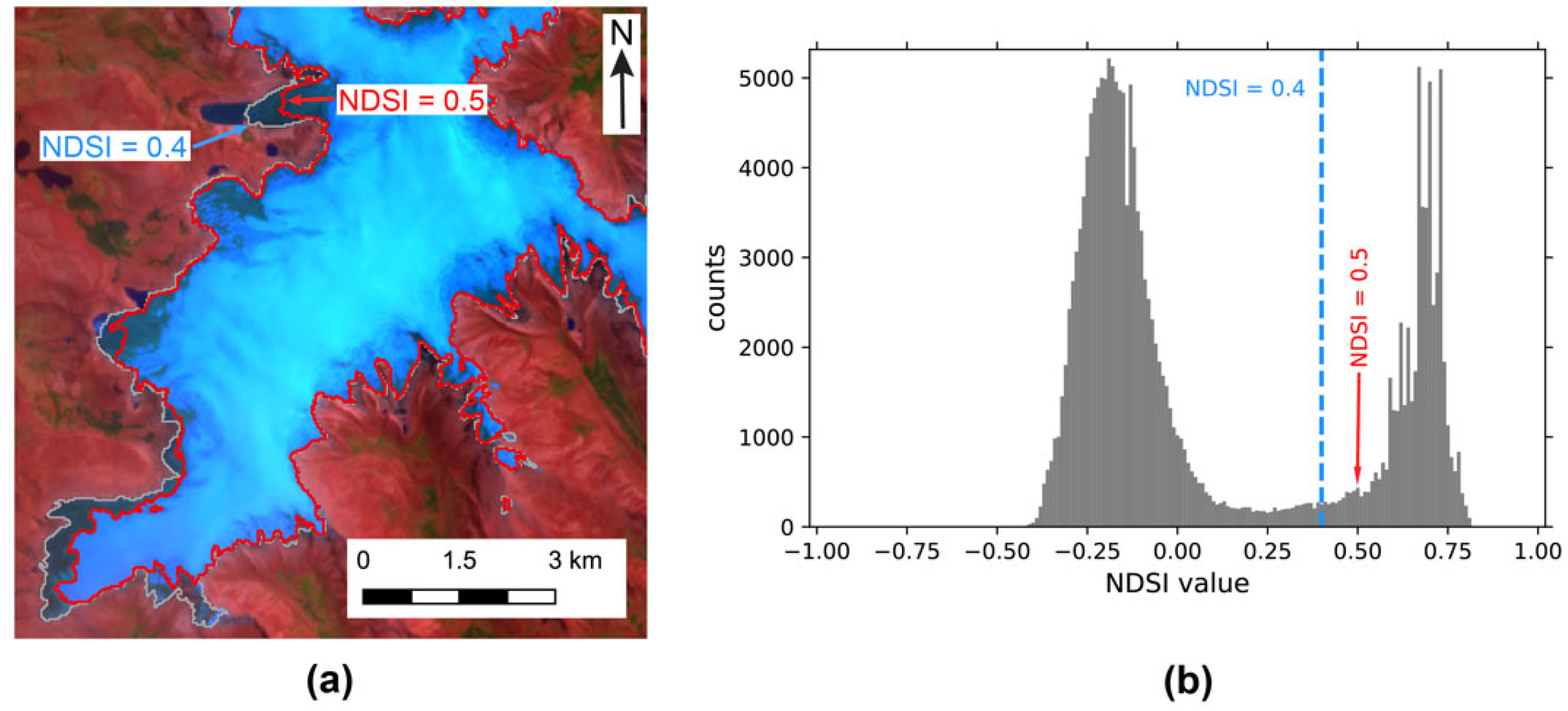
Appendix B
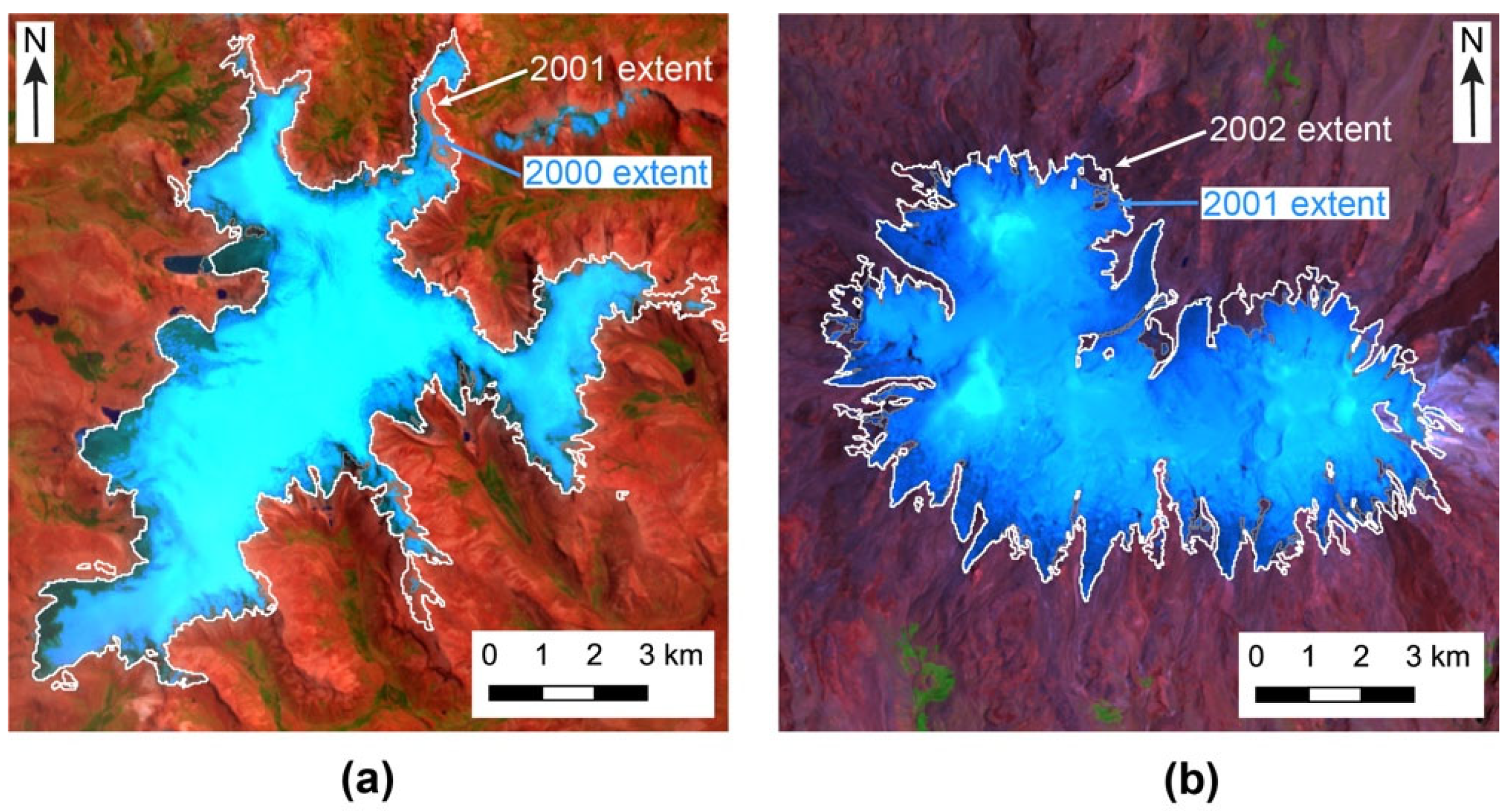
References
- Kaser, G.; Osmaston, H. Tropical Glaciers; Cambridge University Press: Cambridge, UK, 2002. [Google Scholar]
- Vuille, M.; Francou, B.; Wagnon, P.; Juen, I.; Kaser, G.; Mark, B.G.; Bradley, R.S. Climate change and tropical Andean glaciers: Past, present, and future. Earth Sci. Rev. 2008, 89, 79–96. [Google Scholar] [CrossRef]
- Rabatel, A.; Francou, B.; Soruco, A.; Gomez, J.; Cáceres, B.; Caballos, J.L.; Basantes, R.; Vuille, M.; Sicart, J.E.; Huggel, C.; et al. Current state of glaciers in the tropical Andes: A multi-century perspective on glacier evolution and climate change. Cryosphere 2013, 7, 81–102. [Google Scholar] [CrossRef]
- Vuille, M.; Carey, M.; Huggel, C.; Buytaert, W.; Rabatel, A.; Jacobsen, D.; Soruco, A.; Villacis, M.; Yarleque, C.; Timm, O.E.; et al. Rapid decline of snow and ice in the tropical Andes–Impacts, uncertainties and challenges ahead. Earth Sci. Rev. 2018, 176, 195–213. [Google Scholar] [CrossRef]
- Veettil, B.K.; Kamp, U. Global disappearance of Tropical Mountain Glaciers: Observations, Causes, and Challenges. Geosciences 2019, 9, 196. [Google Scholar] [CrossRef]
- Kaser, G. Glacier-climate interactions at low latitudes. J. Glaciol. 2001, 47, 195–204. [Google Scholar] [CrossRef]
- Mark, B.G.; Seltzer, G.O. Tropical glacier meltwater contribution to stream discharge: A case study in the Cordillera Blanca, Peru. J. Glaciol. 2003, 49, 271–281. [Google Scholar] [CrossRef]
- Soruco, A.; Vincent, C.; Rabatel, A.; Francou, B.; Thibert, E.; Sicart, J.E.; Condom, T. Contribution of glacier runoff to water resources of La Paz city, Bolivia (16° S). Ann. Glaciol. 2015, 56, 147–153. [Google Scholar] [CrossRef]
- Vergara, W.; Deeb, A.; Valencia, A.; Bradley, R.; Francou, B.; Zarzar, A.; Grünwaldt, A.; Haeussling, S. Economic impacts of rapid glacier retreat in the Andes. Eos Trans. Am. Geophys. Union 2007, 88, 261–264. [Google Scholar] [CrossRef]
- Kaser, G. A review of the modern fluctuations of tropical glaciers. Glob. Planet. Chang. 1999, 22, 93–103. [Google Scholar] [CrossRef]
- Seehaus, T.; Malz, P.; Sommer, C.; Lippi, S.; Cochachin, A.; Braun, M. Changes of the tropical glaciers throughout Peru between 2000 and 2016–mass balance and area fluctuations. Cryosphere 2019, 13, 2537–2556. [Google Scholar] [CrossRef] [Green Version]
- Thompson, L.G.; Mosley-Thompson, E.; Brecher, H.; Davis, M.; León, B.; Les, D.; Lin, P.N.; Mashiotta, T.; Mountain, K. Abrupt tropical climate change: Past and present. Proc. Natl. Acad. Sci. USA 2006, 103, 10536–10543. [Google Scholar] [CrossRef] [PubMed]
- Kochtitzky, W.H.; Edwards, B.R.; Enderlin, E.M.; Marino, J.; Marinque, N. Improved estimates of glacier change rates at Nevado Coropuna Ice Cap, Peru. J. Glaciol. 2018, 64, 175–184. [Google Scholar] [CrossRef]
- Ames, A.; Evangelista, P.; Valverde, A.; Zúñiga, J. Inventario de Glaciares del Perú; Consejo Nacional de Ciencia y Tecnologia: Huaraz, Peru, 1988; Part 1. [Google Scholar]
- Silverio, W.; Jaquet, J.M. Glacial cover mapping (1987–1996) of the Cordillera Blanca (Peru) using satellite imagery. Remote Sens. Environ. 2005, 95, 342–350. [Google Scholar] [CrossRef]
- Racoviteanu, A.E.; Arnaud, Y.; Williams, M.W.; Ordonez, J. Decadal changes in glacier parameters in the Cordillera Blanca, Peru, derived from remote sensing. J. Glaciol. 2008, 54, 499–510. [Google Scholar] [CrossRef]
- Hanshaw, M.N.; Bookhagen, B. Glacial areas, lake areas, and snow lines from 1975 to 2012: Status of the Cordillera Vilcanota, including the Quelccaya Ice Cap, northern central Andes, Peru. Cryosphere 2014, 8, 359–376. [Google Scholar] [CrossRef]
- Taylor, L.S.; Quincey, D.J.; Smith, M.W.; Potter, E.R.; Castro, J.; Fyffe, C.L. Multi-Decadal Glacier Area and Mass Balance Change in the Southern Peruvian Andes. Front. Earth Sci. 2022, 10, 863933. [Google Scholar] [CrossRef]
- Paul, F. Combined technologies allow rapid analysis of glacier changes. Eos Trans. Am. Geophys. Union 2002, 83, 253–261. [Google Scholar] [CrossRef]
- Paul, F.; Kääb, A.; Haeberli, W. Recent glacier changes in the Alps observed by satellite: Consequences for future monitoring strategies. Glob. Planet. Chang 2007, 56, 111–122. [Google Scholar] [CrossRef]
- Paul, F.; Frey, H.; Le Bris, R. A new glacier inventory for the European Alps from Landsat TM scenes of 2003: Challenges and results. Ann. Glaciol. 2011, 52, 144–152. [Google Scholar] [CrossRef]
- Albert, T.H. Evaluation of remote sensing techniques for ice-area classification applied to the tropical Quelccaya Ice Cap, Peru. Polar Geogr. 2002, 26, 210–226. [Google Scholar] [CrossRef]
- Salzmann, N.; Huggel, C.; Rohrer, M.; Silverio, W.; Mark, B.G.; Burns, P.; Portocarrero, C. Glacier changes and climate trends derived from multiple sources in the data scarce Cordillera Vilcanota region, southern Peruvian Andes. Cryosphere 2013, 7, 103–118. [Google Scholar] [CrossRef]
- Peduzzi, P.; Herold, C.; Silverio, W. Assessing high altitude glacier thickness, volume and area changes using field, GIS and remote sensing techniques: The case of Nevado Coropuna (Peru). Cryosphere 2010, 4, 313–323. [Google Scholar] [CrossRef]
- Silverio, W.; Jaquet, J.M. Multi-temporal and multi-source cartography of the glacial cover of Nevado Coropuna (Arequipa, Peru) between 1955 and 2003. Int. J. Remote Sens. 2012, 33, 5876–5888. [Google Scholar] [CrossRef]
- Veettil, B.K.; Bremer, U.F.; de Souza, S.F.; Maier, É.L.B.; Simões, J.C. Variations in annual snowline and area of an ice-covered stratovolcano in the Cordillera Ampato, Peru, using remote sensing data (1986–2014). Geocarto Int. 2016, 31, 544–556. [Google Scholar] [CrossRef]
- Yarleque, C.; Vuille, M.; Hardy, D.R.; Timm, O.E.; De la Cruz, J.; Ramos, H.; Rabatel, A. Projections of the future disappearance of the Quelccaya Ice Cap in the Central Andes. Sci. Rep. 2018, 8, 15564. [Google Scholar] [CrossRef]
- Oerlemans, J. Glaciers and Climate Change; A.A. Balkema Publishers: Lisse, The Netherlands, 2001. [Google Scholar]
- Thompson, L.G.; Mosley-Thompson, E.; Davis, M.E.; Zagorodnov, V.S.; Howat, I.M.; Mikhalenko, V.N.; Lin, P.N. Annually resolved ice core records of tropical climate variability over the past ~1800 years. Science 2013, 340, 945–950. [Google Scholar] [CrossRef]
- Herreros, J.; Moreno, I.; Taupin, J.D.; Ginot, P.; Patris, N.; De Angelis, M.; Ledru, M.P.; Delachaux, F.; Schotterer, U. Environmental records from temperate glacier ice on Nevado Coropuna saddle, southern Peru. Adv. Geosci. 2009, 22, 27–34. [Google Scholar] [CrossRef]
- Garreaud, R.D.; Vuille, M.; Compagnucci, R.; Marengo, J. Present-day South American climate. Palaeogeogr. Palaeoclimatol. Palaeoecol. 2009, 281, 180–195. [Google Scholar] [CrossRef]
- Sagredo, E.A.; Lowell, T.V. Climatology of Andean glaciers: A framework to understand glacier response to climate change. Glob. Planet. Chang. 2012, 86, 101–109. [Google Scholar] [CrossRef]
- Sagredo, E.A.; Rupper, S.; Lowell, T.V. Sensitivities of the equilibrium line altitude to temperature and precipitation changes along the Andes. Quat. Res. 2014, 81, 355–366. [Google Scholar] [CrossRef]
- Seehaus, T.; Malz, P.; Sommer, C.; Soruco, A.; Rabatel, A.; Braun, M. Mass balance and area changes of glaciers in the Cordillera Real and Tres Cruces, Bolivia, between 2000 and 2016. J. Glaciol. 2020, 66, 124–136. [Google Scholar] [CrossRef]
- Huggel, C.; Kääb, A.; Haeberli, W.; Teysseire, P.; Paul, F. Remote sensing based assessment of hazards from glacier lake outbursts: A case study in the Swiss Alps. Can. Geotech. J. 2002, 39, 316–330. [Google Scholar] [CrossRef]
- Burns, P.; Nolin, A. Using atmospherically-corrected Landsat imagery to measure glacier area change in the Cordillera Blanca, Peru from 1987 to 2010. Remote Sens. Environ. 2014, 140, 165–178. [Google Scholar] [CrossRef]
- Cook, S.J.; Kougkoulos, I.; Edwards, L.A.; Dortch, J.; Hoffmann, D. Glacier change and glacial lake outburst flood risk in the Bolivian Andes. Cryosphere 2016, 10, 2399–2413. [Google Scholar] [CrossRef]
- Veettil, B.K.; Wang, S.; Simões, J.C.; Pereira, S.F.R. Glacier monitoring in the eastern mountain ranges of Bolivia from 1975 to 2016 using Landsat and Sentinel-2 data. Environ. Earth Sci. 2018, 77, 452. [Google Scholar] [CrossRef]
- Albert, T.; Klein, A.; Kincaid, J.L.; Huggel, C.; Racoviteanu, A.E.; Arnaud, Y.; Silverio, W.; Ceballos, J.L. Remote sensing of rapidly diminishing tropical glaciers in the northern Andes. In Global Land Ice Measurements from Space; Kargel, J.S., Leonard, G.J., Bishop, M.P., Kääb, A., Raup, B.H., Eds.; Springer: Berlin/Heidelberg, Germany, 2014; pp. 609–638. [Google Scholar] [CrossRef]
- Úbeda, P.J. El Impacto del Cambio Climático en Los Glaciares del Complejo Volcánico Nevado Coropuna, (Cordillera Occidental de Los Andes Centrales). Ph.D. Thesis, Universidad Complutense de Madrid, Madrid, Spain, 2010. Available online: https://eprints.ucm.es/id/eprint/12076/ (accessed on 1 June 2022).
- Racoviteanu, A.E.; Manley, W.F.; Arnaud, Y.; Williams, M.W. Evaluating digital elevation models for glaciologic applications: An example from Nevado Coropuna, Peruvian Andes. Glob. Planet. Chang. 2007, 59, 110–125. [Google Scholar] [CrossRef]
- Roe, G.H.; Baker, M.B. Glacier response to climate perturbations: An accurate linear geometric model. J. Glaciol. 2014, 60, 670–684. [Google Scholar] [CrossRef] [Green Version]
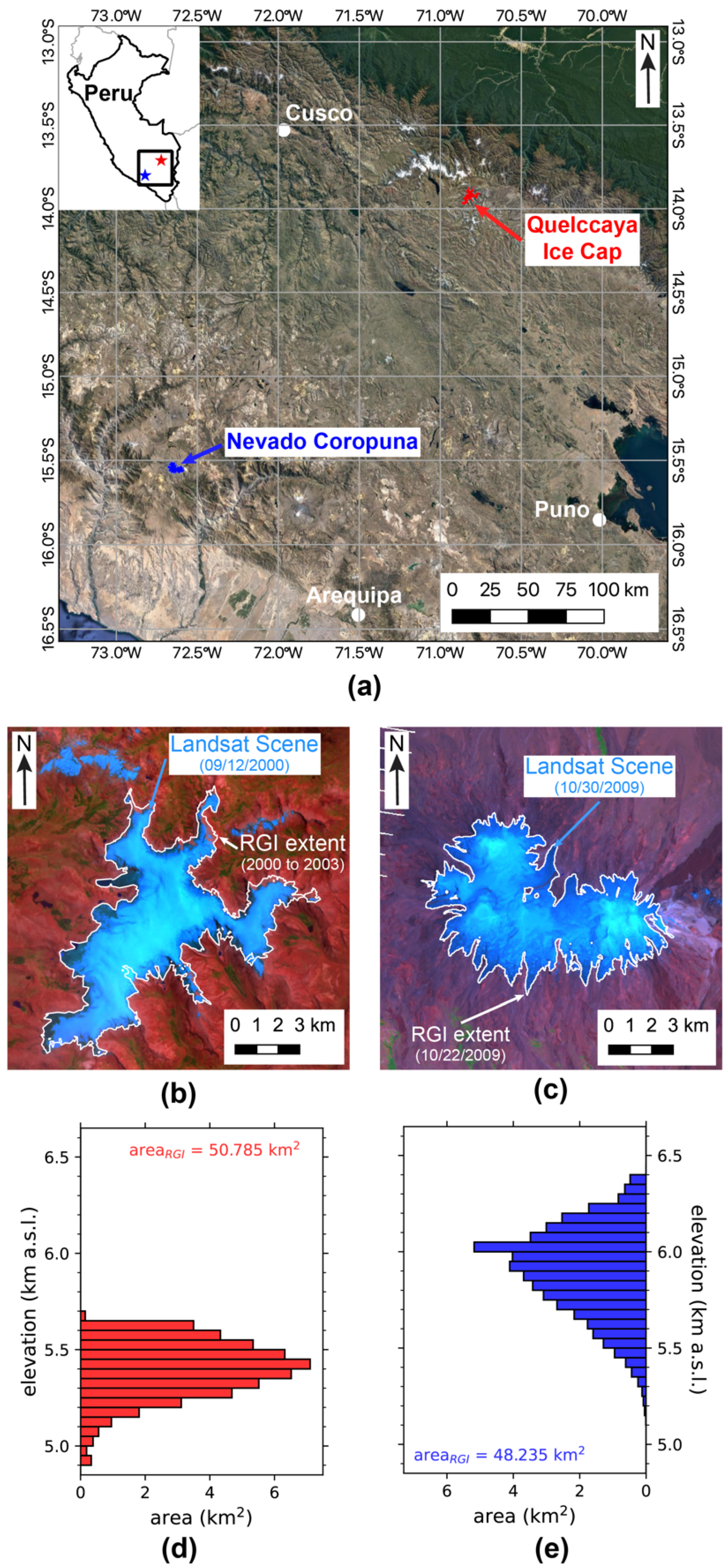
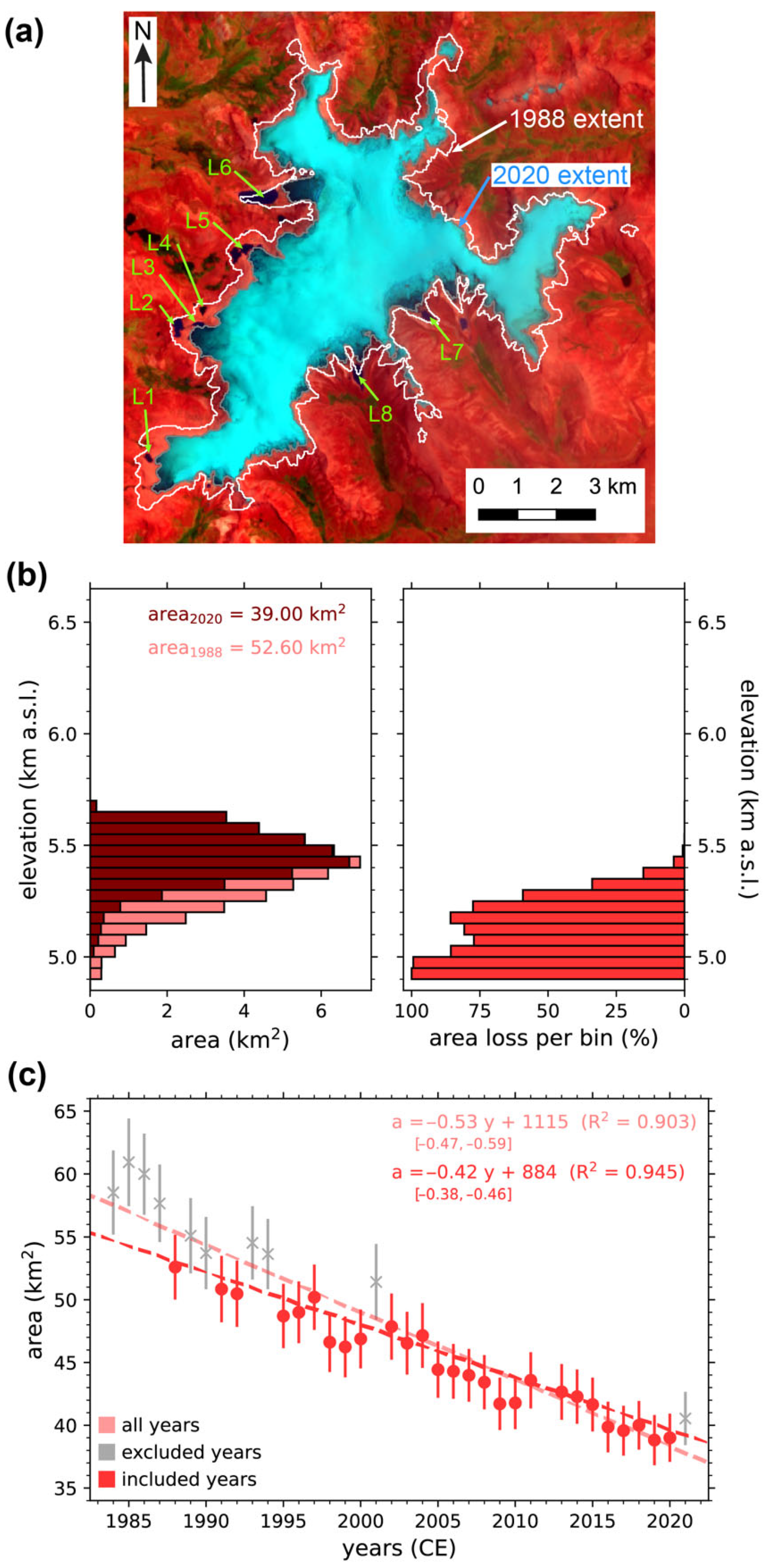
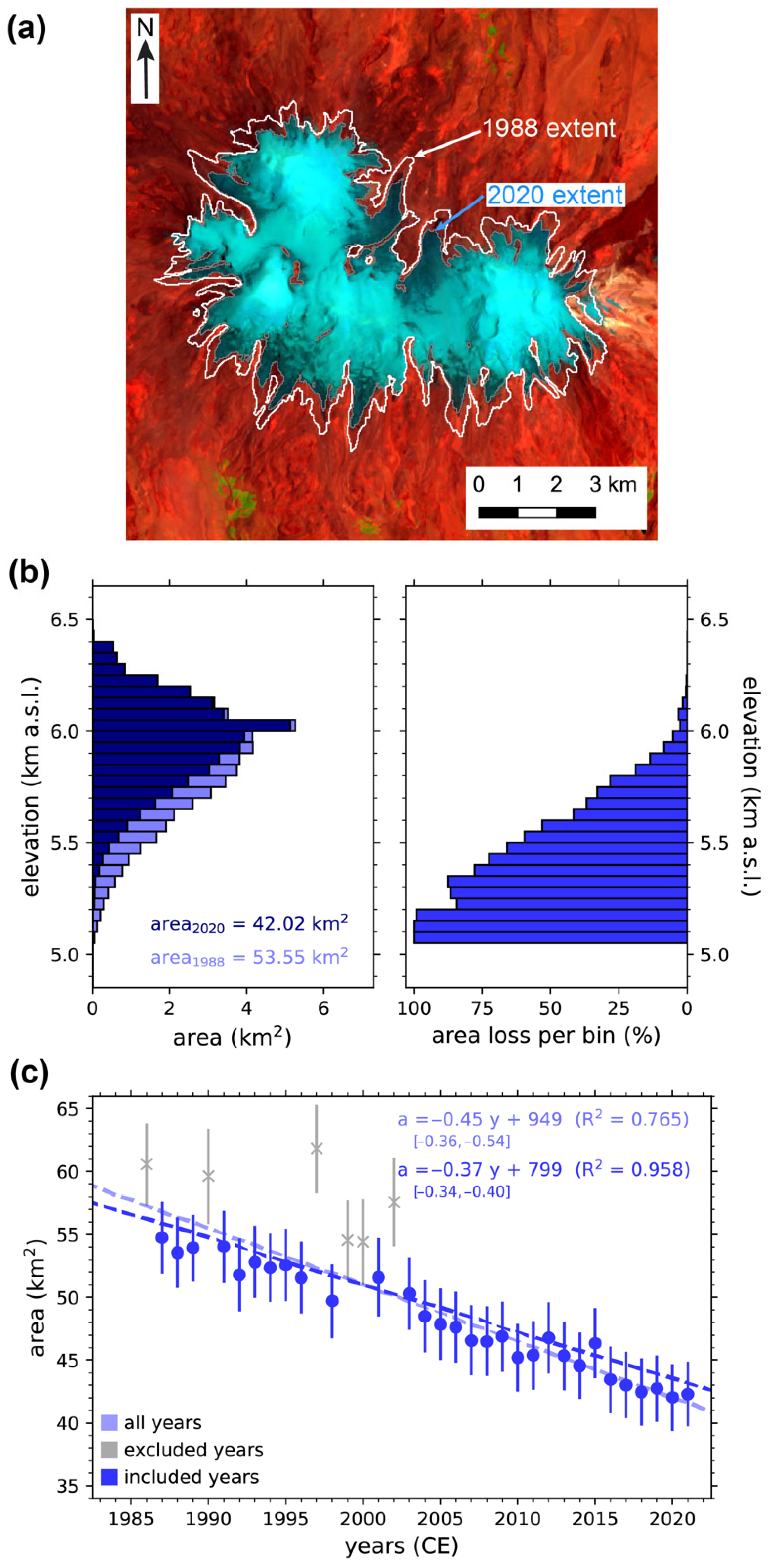
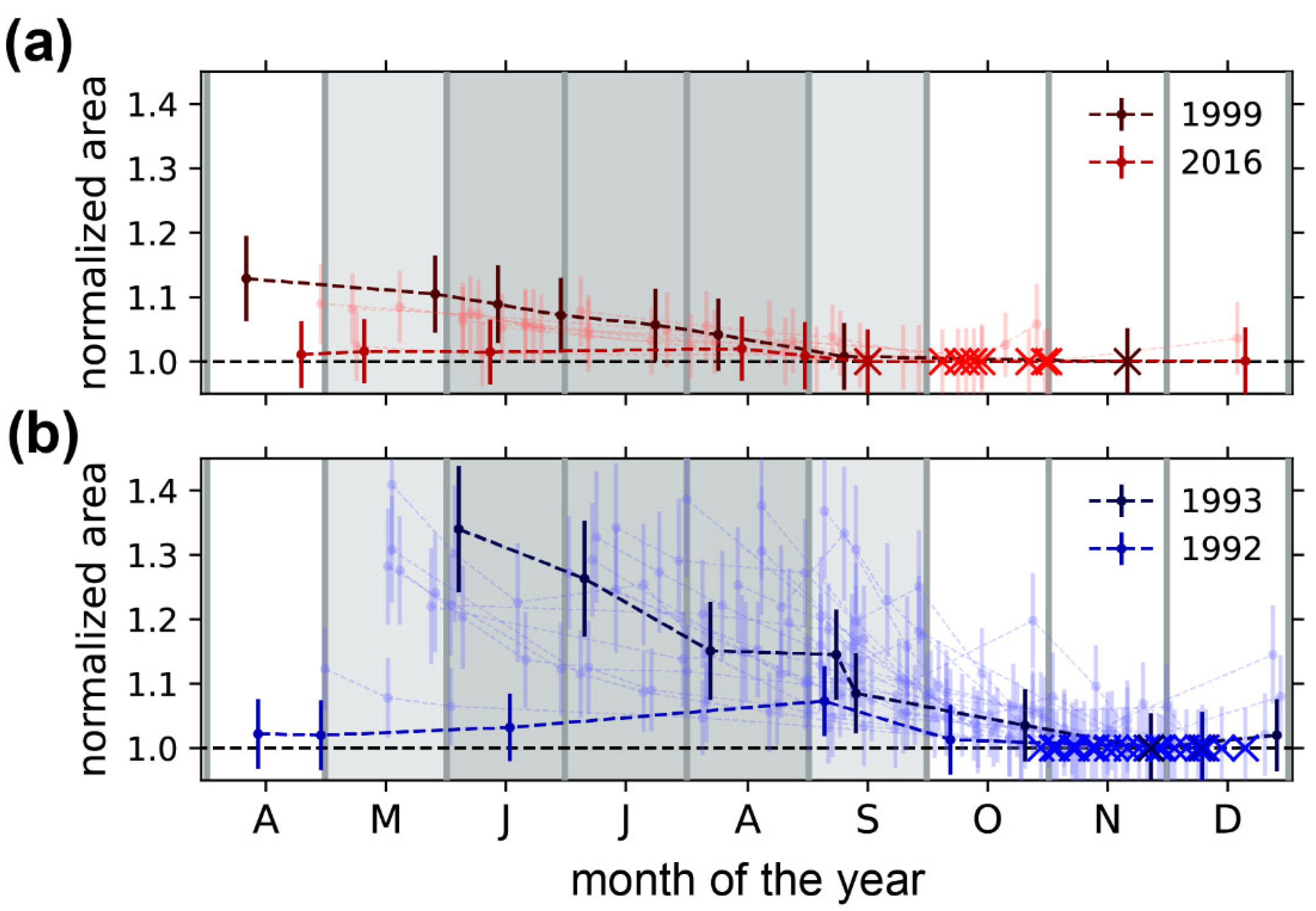
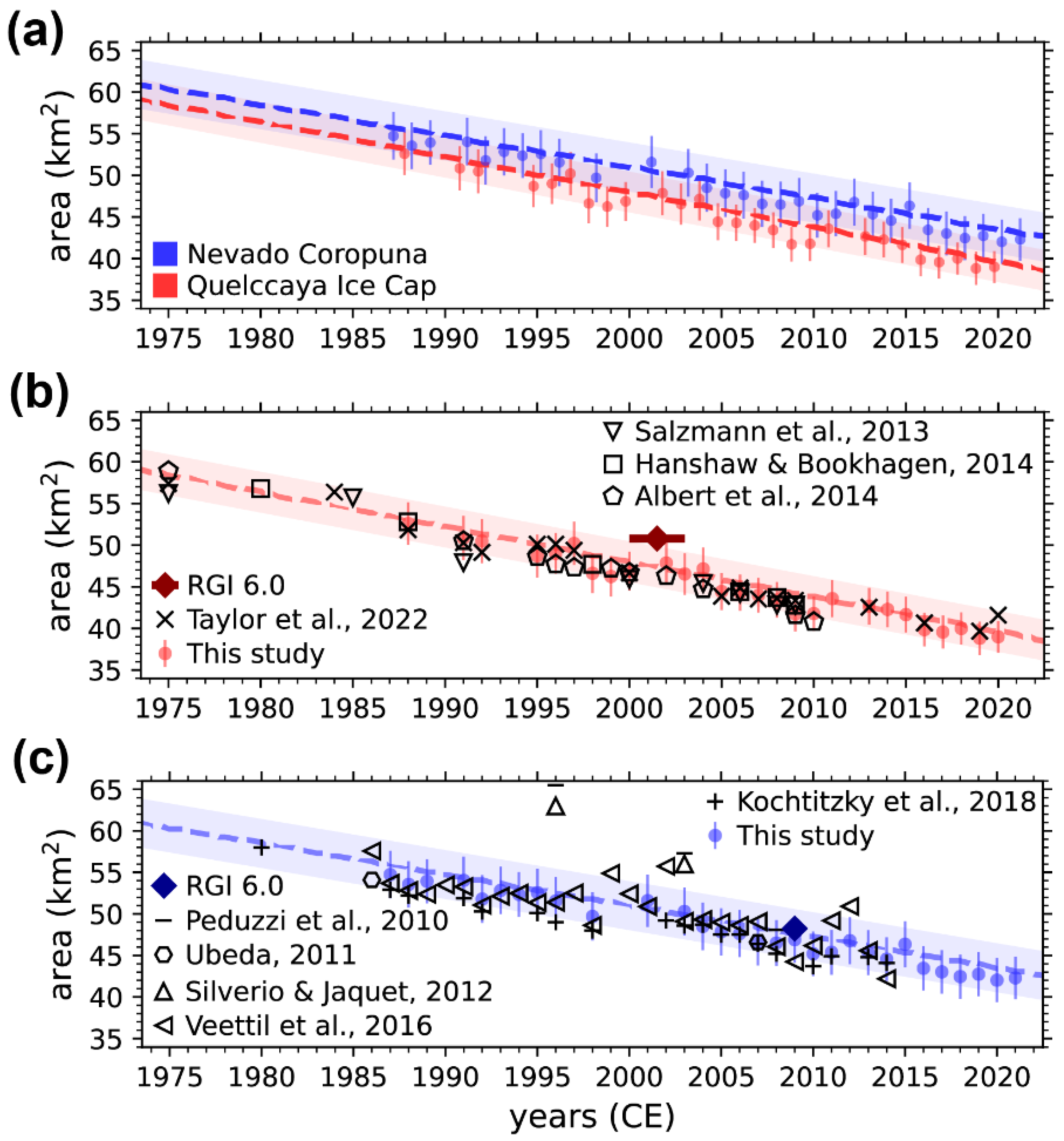
Publisher’s Note: MDPI stays neutral with regard to jurisdictional claims in published maps and institutional affiliations. |
© 2022 by the authors. Licensee MDPI, Basel, Switzerland. This article is an open access article distributed under the terms and conditions of the Creative Commons Attribution (CC BY) license (https://creativecommons.org/licenses/by/4.0/).
Share and Cite
Malone, A.G.O.; Broglie, E.T.; Wrightsman, M. The Evolution of the Two Largest Tropical Ice Masses since the 1980s. Geosciences 2022, 12, 365. https://doi.org/10.3390/geosciences12100365
Malone AGO, Broglie ET, Wrightsman M. The Evolution of the Two Largest Tropical Ice Masses since the 1980s. Geosciences. 2022; 12(10):365. https://doi.org/10.3390/geosciences12100365
Chicago/Turabian StyleMalone, Andrew G. O., Eleanor T. Broglie, and Mary Wrightsman. 2022. "The Evolution of the Two Largest Tropical Ice Masses since the 1980s" Geosciences 12, no. 10: 365. https://doi.org/10.3390/geosciences12100365
APA StyleMalone, A. G. O., Broglie, E. T., & Wrightsman, M. (2022). The Evolution of the Two Largest Tropical Ice Masses since the 1980s. Geosciences, 12(10), 365. https://doi.org/10.3390/geosciences12100365







